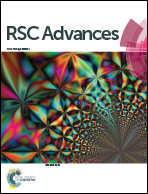All-solid-state nanocomposite electrolytes composed of an ionic polymer with polar groups and surface-modified SiO2 nanoparticles for dye-sensitized solar cells†
Abstract
Solid-state electrolytes based on ionic polymer (IP)–SiO2 nanocomposite are prepared for dye-sensitized solar cells (DSCs). An IP with a cationic main chain and polar ester and carbonyl groups is synthesized from 2,3-dichloropropionic acid methyl ester and N,N′-carbonyldiimidazole. SiO2 nanoparticles are chemically modified by silane coupling agents KH550 and KH570. The polar groups in the IP and on the surface of the modified SiO2 can facilitate the ionization of iodide in the electrolyte and increase the number of charge carriers. Moreover, according to the principle of ‘like dissolves like’, SiO2 modified by polar groups can be compatible with the IP and yield a long-term stability for the electrolyte. Eventually, the solid-state electrolyte containing IP and modified SiO2 achieves a high conductivity of 3.05 mS cm−1. The all-solid-state DSCs with the composite electrolyte have favorable stability and photo-to-current conversion efficiencies of 5.03% at 30 mW cm−2 and 4.86% at 100 mW cm−2.


 Please wait while we load your content...
Please wait while we load your content...